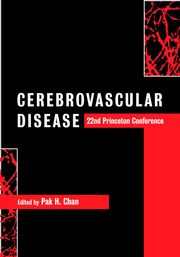Book contents
- Frontmatter
- Contents
- List of contributors
- Preface
- Acknowledgments
- Part I Special lectures
- Part II Oxidative stress
- Part III Apoptosis
- Part IV Hot topics
- 10 Astrocytes in ischemic stroke
- 11 Aquaporin-4 water channels and brain edema
- 12 Neuroprotection with tetracyclines in brain ischemia models
- 13 Spreading depression: a teleological means for self-protection from brain ischemia
- Part V Hemorrhage, edema and secondary injury
- Part VI Inflammation
- Part VII Gene transfer and therapy
- Part VIII Neurogenesis and plasticity
- Part IX Magnetic resonance imaging in clinical stroke
- Part X Risk factors, clinical trials and new therapeutic horizons
- Index
- Plate section
11 - Aquaporin-4 water channels and brain edema
from Part IV - Hot topics
Published online by Cambridge University Press: 02 November 2009
- Frontmatter
- Contents
- List of contributors
- Preface
- Acknowledgments
- Part I Special lectures
- Part II Oxidative stress
- Part III Apoptosis
- Part IV Hot topics
- 10 Astrocytes in ischemic stroke
- 11 Aquaporin-4 water channels and brain edema
- 12 Neuroprotection with tetracyclines in brain ischemia models
- 13 Spreading depression: a teleological means for self-protection from brain ischemia
- Part V Hemorrhage, edema and secondary injury
- Part VI Inflammation
- Part VII Gene transfer and therapy
- Part VIII Neurogenesis and plasticity
- Part IX Magnetic resonance imaging in clinical stroke
- Part X Risk factors, clinical trials and new therapeutic horizons
- Index
- Plate section
Summary
Introduction
Abnormalities in brain water balance, such as edema and increased intracranial pressure, play an important role in the pathophysiology of acute head trauma, stroke and a variety of neurological disorders. However, little is known about the molecular mechanisms responsible for these alterations in cerebral water balance. Consequently, at present the therapeutic options are limited to neurosurgical decompression, intravenous administration of hyperosmolar agents and steroids, therapies that were introduced more than 40 years ago. There is recent evidence that molecular water channels called aquaporins, which have recently been identified in mammals, may play an important role in brain edema, thus offering therapeutic alternatives.
Aquaporins are small integral membrane proteins that function primarily as bidirectional water-selective transporters in many cell types in the kidney, lung and other fluid-transporting tissues where water flow is driven by osmotic gradients and hydrostatic pressure differences. The brain expresses at least two members of the aquaporin family in areas that are known to participate in the production and absorption of brain fluid. Aquaporin-1 is selectively expressed on the ventricular surface of choroid plexus epithelium where it may play a role in cerebrospinal fluid (CSF) production. Aquaporin-4 (AQP4) is abundantly expressed throughout the brain, particularly at the blood–brain and brain–CSF interfaces. AQP4 is expressed to a much lesser extent in tissue outside of the nervous system.
- Type
- Chapter
- Information
- Cerebrovascular Disease22nd Princeton Conference, pp. 125 - 134Publisher: Cambridge University PressPrint publication year: 2002
- 1
- Cited by



